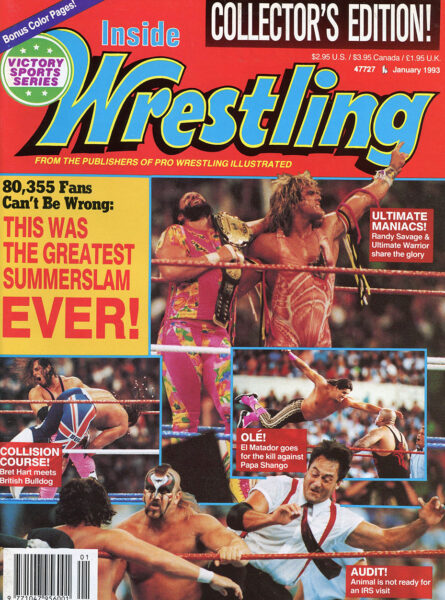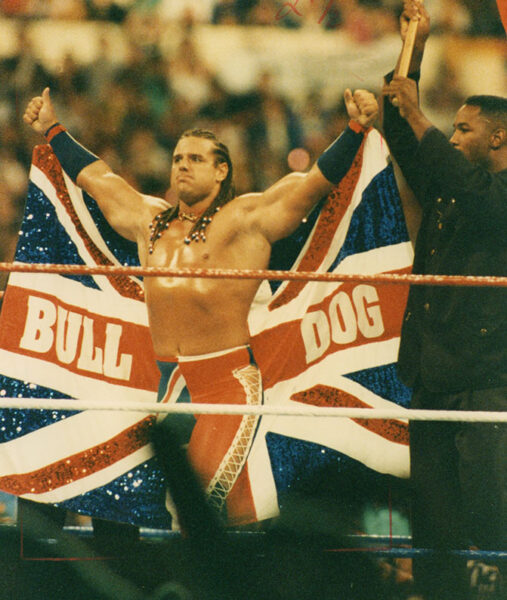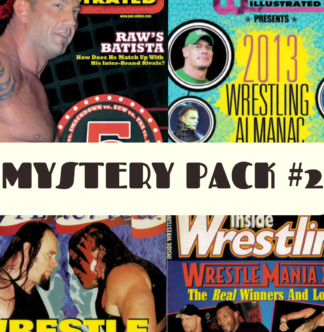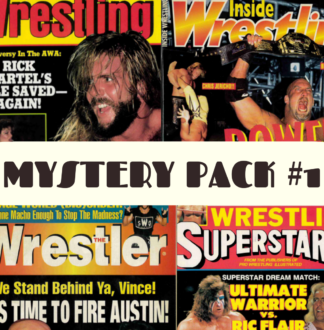REMEMBERING SUMMERSLAM 1992
WWF’s Historic Wembley Stadium Event, 30 Years Later

THE YEAR WAS 1992. Batman Returns was pulling people into movie theaters, Grunge superstars like Nirvana and Pearl Jam were all over the music charts. And, on The Simpsons, Homer’s half-brother Herb had just invented a machine that translated “baby-talk” and restored his fortune in the process.
In the wrestling world, the WWF was enjoying notably less success than some of its counterparts in the sports and entertainment industries. After the rip-roaring “Rock ‘n’ Wrestling” era and the boom of the late-’80s, things had begun to slow down for the industry leader in the 1990s. With Hulk Hogan focusing time and energy on movie projects, the WWF lost its biggest star—at least, on a full-time basis—and the Ultimate Warrior, although popular, hadn’t been able to fill that void. Worse was to come, however, and the WWF would be forced to change the way it did business as a result.
Part of the attraction of the WWF in the 1980s was its colorful characters with their larger-than-life physiques. Of course, those physiques didn’t always come naturally. And the promotion, and Vince McMahon, soon became embroiled in a controversy regarding the alleged distribution of steroids to WWF performers. Enough has been reported about this subject elsewhere that it doesn’t need repeating here. But, in a nutshell, the WWF soon made the decision to (mostly) move away from wrestlers bulging with muscles and instead focus on “smaller,” more athletic performers like Bret Hart and Shawn Michaels. While this move may have improved the quality of the wrestling happening in the ring, it did little to improve things at the box office. WWF business saw a notable decline throughout 1992.
With SummerSlam scheduled for the Capital Centre in Landover, Maryland, WWF brass began to wonder what they could do to generate some interest for their summer pay-per-view—and at least make it appear that things weren’t all bad. As it turned out, things actually weren’t all that bad, at least not in every aspect of their business. In fact, one area of business was booming: the product’s popularity in the United Kingdom. The WWF began to wonder if that might be the answer to its SummerSlam problem.
SKY, the satellite television service, had arrived in the U.K. in 1989, and, with its arrival, brought previously unseen programming such as the aforementioned Simpsons to British audiences. Another early hit for the service was WWF wrestling, which became the most widely viewable wrestling product in the U.K. in many years. Indeed, the colorful and showy American brand of wrestling was a far cry from the often-drab stylings of the traditional British offerings. U.K. viewers couldn’t get enough.
Throughout 1990 and 1991, the WWF picked up steam and grew its presence in the British Isles, to the point where kids were turning up to school with WWF trading cards and stickers to swap with their friends. The fact that the WWF product had cooled down in the U.S. meant nothing across the Atlantic Ocean. To British viewers, the WWF was a new and vibrant form of entertainment. Whenever the company put on house shows across the pond, British fans turned out in droves.
Emboldened by this (and worried about poor ticket sales stateside), the WWF made the decision to move SummerSlam 1992 to London, England. Never one to aim small, however, Vince McMahon wanted to book the company’s first PPV outside of North America in a grand location. After briefly looking at arenas, the conclusion was drawn that maybe the promotion had the potential to fill a stadium. In the end, the most famous (and biggest) venue in England was chosen: Wembley Stadium.
Home to historic events like the 1966 World Cup final and the Live Aid concert in 1985, Wembley was an iconic venue that would provide an excellent visual presentation. Still, filling the vast stadium was an ambitious task. Much to WWF’s delight, however, their gamble paid off. Tickets sold like proverbial hot cross buns, with fans traveling from all over the U.K. and Europe to get a taste of big-time American pro wrestling.
Held on Saturday, August 29 (and airing on tape delay two days later) before a massive, reported crowd of 80,355 people, SummerSlam 1992 would pull in $3,650,000 through ticket sales and merchandise. This was a hugely successful day for the WWF … and a far cry from anything it was doing in the U.S. at the time. Even the notoriously fickle British weather cooperated, and the rain stayed away from the open-air venue for the duration of the show.
Alongside cool visuals like the Legion of Doom riding motorcycles to the ring for their match against Money Inc., and The Undertaker traveling atop a hearse to face off with Kamala, fans were treated to such clashes as The Ultimate Warrior vs. Randy Savage for the WWF championship and an underrated match-up between Shawn Michaels and Rick Martel. But the match everyone had truly come to see was Intercontinental champion Bret Hart defending his title against his real-life brother-in-law, “British Bulldog” Davey Boy Smith. Given the popularity of Smith in his native Britain, the WWF made the sensible decision to allow the Intercontinental match to go on last—an unheard-of prospect at a time when the main WWF belt was also being defended on the same show.

In a battle that would go on to be named PWI Match of the Year for 1992, Hart and Smith put on a clinic that had the 80,000+ in attendance hanging on every move. After 25 minutes, it was local lad Smith who got the win and sent the crowd in Wembley into a frenzy. His celebration brought to a close one of the most unique events the WWF had ever promoted.
“I had the opportunity to sit in the crowd, and I remember how big it was and how passionate it was,” Stephanie McMahon told Sports Illustrated in 2021. “I remember it was raining, and I remember how the rain stopped as soon as the first match started. I also remember how over the British Bulldog was with the crowd. It was a beautiful ride of emotions, a spectacle, and I loved being there.”

I, too, have fond memories of this event. The VHS tape of SummerSlam 1992 was released on September 24 of that year, which happened to be my seventh birthday. I still remember the excitement I felt when my parents handed me the tape of the show that British wrestling fans had been buzzing about. SummerSlam 1992 was the first wrestling VHS tape I ever owned, and I must have watched it a half-dozen times that first week. While it’s not my favorite wrestling event of all time, it is still one of the most special to me. As SummerSlam 1992 celebrates its 30th anniversary, you’ll have to excuse me if, before I watch Roman Reigns and Brock Lesnar throw down at a stadium in Nashville, I go and pop in that old VHS tape and watch Crush and Repo Man throw down in London.




